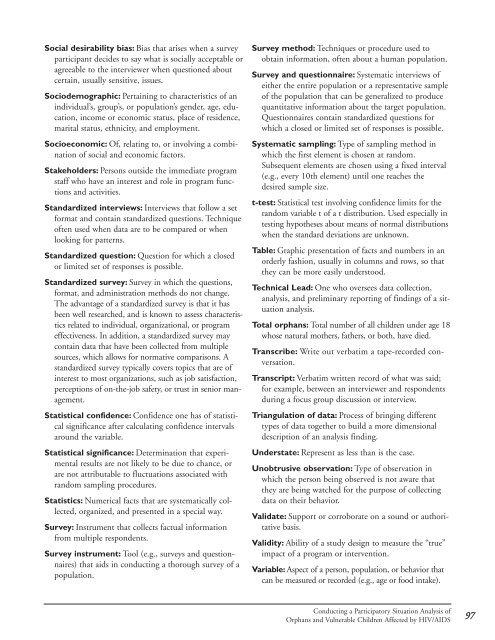Conducting a Participatory Situation Analysis of.pdf - Global HIV ...
Conducting a Participatory Situation Analysis of.pdf - Global HIV ...
Conducting a Participatory Situation Analysis of.pdf - Global HIV ...
Create successful ePaper yourself
Turn your PDF publications into a flip-book with our unique Google optimized e-Paper software.
Social desirability bias: Bias that arises when a survey<br />
participant decides to say what is socially acceptable or<br />
agreeable to the interviewer when questioned about<br />
certain, usually sensitive, issues.<br />
Sociodemographic: Pertaining to characteristics <strong>of</strong> an<br />
individual’s, group’s, or population’s gender, age, education,<br />
income or economic status, place <strong>of</strong> residence,<br />
marital status, ethnicity, and employment.<br />
Socioeconomic: Of, relating to, or involving a combination<br />
<strong>of</strong> social and economic factors.<br />
Stakeholders: Persons outside the immediate program<br />
staff who have an interest and role in program functions<br />
and activities.<br />
Standardized interviews: Interviews that follow a set<br />
format and contain standardized questions. Technique<br />
<strong>of</strong>ten used when data are to be compared or when<br />
looking for patterns.<br />
Standardized question: Question for which a closed<br />
or limited set <strong>of</strong> responses is possible.<br />
Standardized survey: Survey in which the questions,<br />
format, and administration methods do not change.<br />
The advantage <strong>of</strong> a standardized survey is that it has<br />
been well researched, and is known to assess characteristics<br />
related to individual, organizational, or program<br />
effectiveness. In addition, a standardized survey may<br />
contain data that have been collected from multiple<br />
sources, which allows for normative comparisons. A<br />
standardized survey typically covers topics that are <strong>of</strong><br />
interest to most organizations, such as job satisfaction,<br />
perceptions <strong>of</strong> on-the-job safety, or trust in senior management.<br />
Statistical confidence: Confidence one has <strong>of</strong> statistical<br />
significance after calculating confidence intervals<br />
around the variable.<br />
Statistical significance: Determination that experimental<br />
results are not likely to be due to chance, or<br />
are not attributable to fluctuations associated with<br />
random sampling procedures.<br />
Statistics: Numerical facts that are systematically collected,<br />
organized, and presented in a special way.<br />
Survey: Instrument that collects factual information<br />
from multiple respondents.<br />
Survey instrument: Tool (e.g., surveys and questionnaires)<br />
that aids in conducting a thorough survey <strong>of</strong> a<br />
population.<br />
Survey method: Techniques or procedure used to<br />
obtain information, <strong>of</strong>ten about a human population.<br />
Survey and questionnaire: Systematic interviews <strong>of</strong><br />
either the entire population or a representative sample<br />
<strong>of</strong> the population that can be generalized to produce<br />
quantitative information about the target population.<br />
Questionnaires contain standardized questions for<br />
which a closed or limited set <strong>of</strong> responses is possible.<br />
Systematic sampling: Type <strong>of</strong> sampling method in<br />
which the first element is chosen at random.<br />
Subsequent elements are chosen using a fixed interval<br />
(e.g., every 10th element) until one reaches the<br />
desired sample size.<br />
t-test: Statistical test involving confidence limits for the<br />
random variable t <strong>of</strong> a t distribution. Used especially in<br />
testing hypotheses about means <strong>of</strong> normal distributions<br />
when the standard deviations are unknown.<br />
Table: Graphic presentation <strong>of</strong> facts and numbers in an<br />
orderly fashion, usually in columns and rows, so that<br />
they can be more easily understood.<br />
Technical Lead: One who oversees data collection,<br />
analysis, and preliminary reporting <strong>of</strong> findings <strong>of</strong> a situation<br />
analysis.<br />
Total orphans: Total number <strong>of</strong> all children under age 18<br />
whose natural mothers, fathers, or both, have died.<br />
Transcribe: Write out verbatim a tape-recorded conversation.<br />
Transcript: Verbatim written record <strong>of</strong> what was said;<br />
for example, between an interviewer and respondents<br />
during a focus group discussion or interview.<br />
Triangulation <strong>of</strong> data: Process <strong>of</strong> bringing different<br />
types <strong>of</strong> data together to build a more dimensional<br />
description <strong>of</strong> an analysis finding.<br />
Understate: Represent as less than is the case.<br />
Unobtrusive observation: Type <strong>of</strong> observation in<br />
which the person being observed is not aware that<br />
they are being watched for the purpose <strong>of</strong> collecting<br />
data on their behavior.<br />
Validate: Support or corroborate on a sound or authoritative<br />
basis.<br />
Validity: Ability <strong>of</strong> a study design to measure the “true”<br />
impact <strong>of</strong> a program or intervention.<br />
Variable: Aspect <strong>of</strong> a person, population, or behavior that<br />
can be measured or recorded (e.g., age or food intake).<br />
<strong>Conducting</strong> a <strong>Participatory</strong> <strong>Situation</strong> <strong>Analysis</strong> <strong>of</strong><br />
Orphans and Vulnerable Children Affected by <strong>HIV</strong>/AIDS<br />
97















